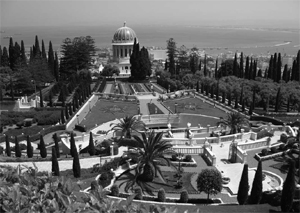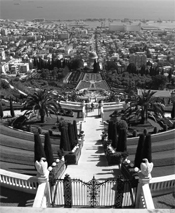
October,
2006
A
Spiritual Journey
By Nathalie Thirlwall
"I felt like I had entered
paradise. Walking along Ben Gurion Avenue in Haifa, Israel, you have
only to glance up the slopes of Mount Carmel, which overlooks this port
city, to find yourself in a heavenly place.

On
the Upper Terraces of Mount Carmel over looking the Shrine of the Bab,
with the city of Haifa and the Mediterranean Sea in the distance.
- Photo by Nathalie Thirlwall |

Half way up Mount Carmel overlooking the Shrine of the Bab, with theMediterranean Sea in the distance.
- Photo by Nathalie Thirlwall |
It was 19 years ago that I had last touched the sacred soil of the Holy
Land, terrain that is the home to many religions. My recent Baha’i
pilgrimage to Haifa and Bahji, near Acre, Israel was a marvelous and
profound experience, that, to cite a Baha’i prayer, “refreshed and
gladdened my spirit”.
Overlooking the Mediterranean Sea in the heart of Mount Carmel, the
golden-domed Shrine of the Bab is Haifa’s most recognizable landmark.
The final resting place of the Bab (“the Gate”), the martyred herald of
the Baha’i Faith, the shrine is surrounded by cascading gardens that
stretch a full kilometre up the side of the mountain.
Surprisingly, two Canadian architects are responsible for much of the
beauty that spills down Mount Carmel. While the simple inner stone
shrine of the Bab was built in the early 1900s, the colonnade and
golden dome over the mausoleum was designed by Canadian architect
William Sutherland Maxwell and erected in 1953. Maxwell is best known
as the architect of the Regina Parliament building and the tower of the
Chateau Frontenac in Quebec city.
Toronto architect Fariborz Sahba designed the monumental tiered gardens
that opened in 2001. They consist of eighteen terraces, nine above and
nine below the shrine. To create a continuous pedestrian pathway from
the foot to the crest of the mountain, bridges and walking underpasses
were built to cross three streets. Sabha is also the architect of the
acclaimed and newest Baha’i temple now under construction in Santiago,
Chile.
The terraces offer pilgrims and visiting tourists benches to rest and
contemplate the surrounding beauty that tantalizes the senses. The
sounds of the city fade as the songs of birds mingle with the murmur of
gently cascading fountains. As you walk along pathways, red tiles
tinkle at your feet. An array of carefully selected and placed shrubs,
trees and ornaments heightens the sense of peace and harmony. The
scents of many fragrant flowers waft through the air. Natural elements
of light and water are used extensively in the terraces, along with
decoratively chiseled and sculptured work of stone and metal. Great
attention is paid to detail. Each site and spot offers a
fresh visual delight.
A distinguishing feature of the gardens is their conservation of the
mountain environment and water resources. The formal gardens along the
terraces’ central axis blend on either side into informal gardens
featuring drought-resistant native trees and wildflowers. The water
used for the fountains is reclaimed and recycled.
Haifa is the world centre of the Baha’i Faith, which started in Persia
in 1844. A succession of banishments brought its founder, Baha’u’Ilah,
to the prison city of Acre in 1868. His shrine, located in Bahji, a
secluded area away from the city core, is also a place of pilgrimage
for Baha’is.
In addition to the Shrine of the Bab, four other Baha’i buildings are
located on the slopes of Mount Carmel. They are the Seat of the
Universal House of Justice, headquarters for the international
governing body of the worldwide Baha’i community, the International
Baha’i Archives, the Centre for the Study of the Texts (Baha’i sacred
writings) and the International Teaching Centre Building. Even these
administrative buildings, with their neoclassical style, embody
dignity, integrity and elegance. After over a decade of construction,
the two latest buildings and the terraces were completed and officially
opened in 2001.
Every year, thousands of Baha’i pilgrims from around the world quietly
pay homage to their faith at these holy sites. Many more thousands of
tourists visit them by the busload during the public hours. A
refreshing feature is that there are no admission fees to any of the
holy places, and no souvenirs are sold. Construction has been funded by
voluntary donations from the six million Baha’is around the world. No
contributions are accepted from outside sources. The Baha’i World
Centre is staffed by over 1,000 volunteers from many countries.
But these facts and figures disappear from one’s mind when visiting the
Baha’i gardens. Their pristine beauty uplifts your spirit and enables
you to transcend daily existence and obtain a glimpse into the divine.
In this reverent environment, you recognize and gain respect for the
sacred. You see balance and harmony, experience peacefulness and
tranquility. You are welcomed and comforted by the gentle and helpful
volunteers and feel the profound joy that stems from being surrounded
and embraced by aesthetic perfection. You become detached from the
consuming materialism of the material world and soar into the realm of
the spirit, where souls wing their flight towards their Creator. Is
this not paradise?
For more information on the opening of the Terraces of the Shrine of
the Bab go to http://www.bahaiworldnews.com/terraces/terraces.en.html.
Printed
in The Community Voice of Old Ottawa South
October,
2006
|